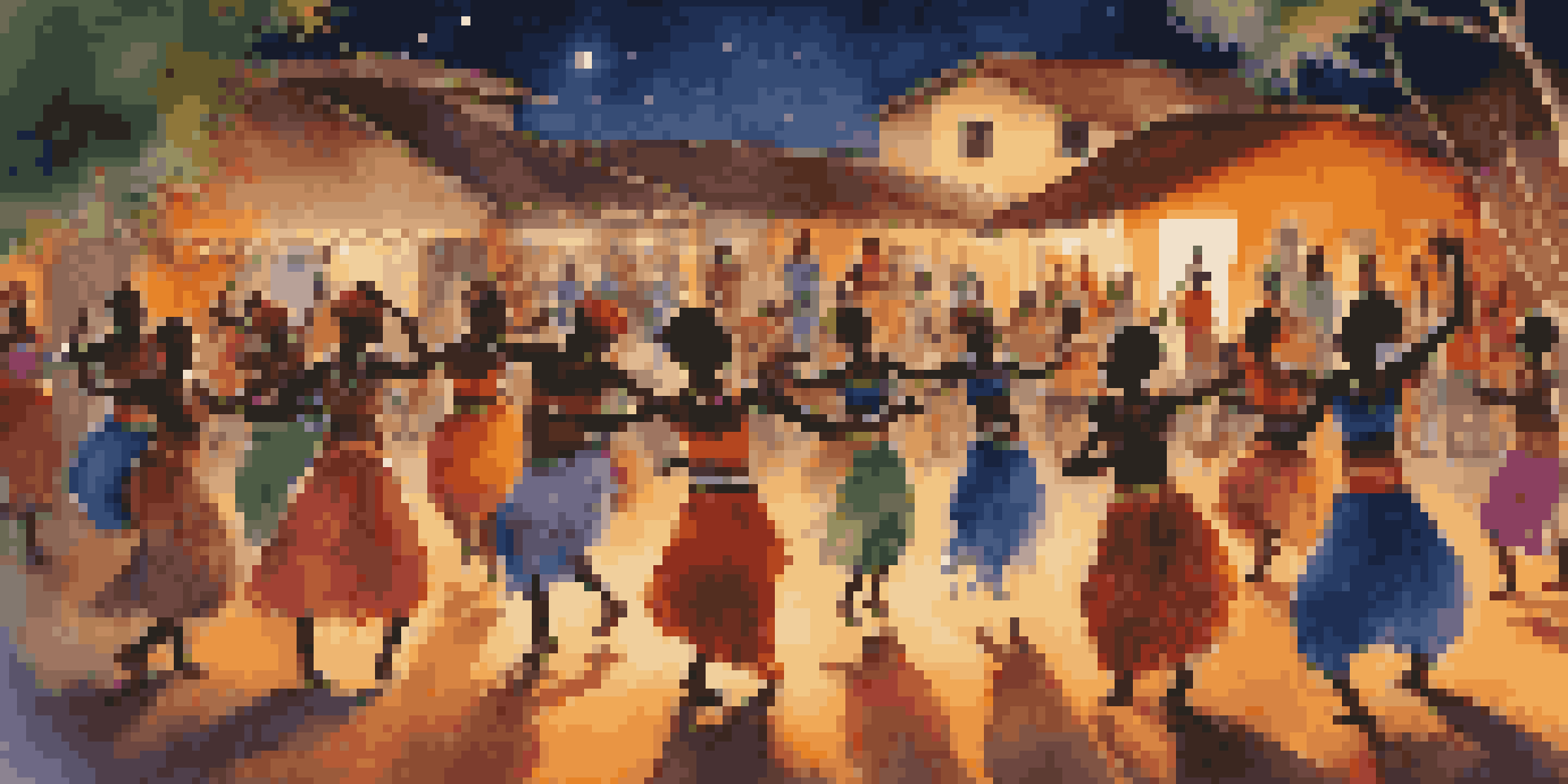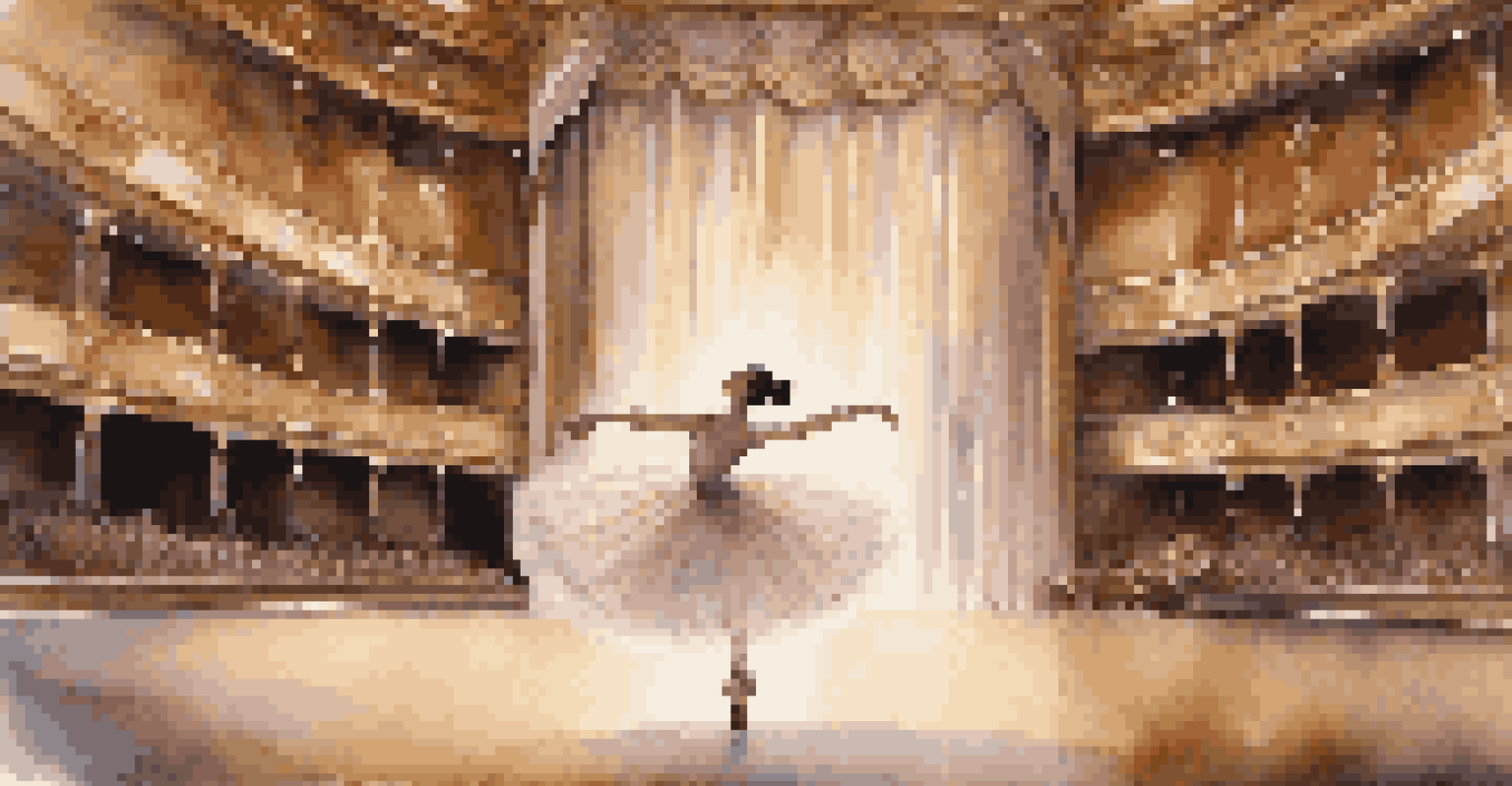Exploring Dance Forms Across Cultures and Their Music Links

The Universal Language of Dance and Music
Dance and music have been intertwined since the dawn of human expression. They serve as universal languages, transcending barriers of culture, geography, and time. Each movement in dance often reflects the rhythm and melody of the accompanying music, creating a symbiotic relationship that tells a story.
Dance is the hidden language of the soul.
For instance, think about how a traditional Irish jig dances in harmony with the lively notes of a fiddle. The energetic footwork mirrors the upbeat tempo, making it hard not to tap your own feet along. This connection between dance and music is a fundamental aspect of many cultures, showcasing their unique identities.
As we explore various dance forms, we'll see how they not only serve as entertainment but also as a medium for cultural expression and preservation. Understanding this relationship helps us appreciate the beauty of diversity in the world of dance and music.
African Dance: Rhythms of Life and Community
In many African cultures, dance is a vital part of community life, often performed during rituals, celebrations, and storytelling. The connection between movement and music is profound, with drumming often at the core of these experiences. The polyrhythmic beats of traditional African drums inspire dancers to express their emotions and tell their stories through movement.

For example, the West African dance form 'Agbekor' is performed to celebrate victory and honor ancestors. The intricate footwork and expressive upper body movements are driven by the rhythms of the drums, creating a powerful narrative that resonates with both participants and spectators. This dance form exemplifies how music and dance work together to strengthen community bonds.
Dance and Music as Universal Languages
Dance and music transcend cultural and geographical barriers, serving as powerful mediums for storytelling and expression.
Moreover, African dance often emphasizes the importance of collective participation, highlighting the role of the community in each performance. This communal aspect makes the experience richer and reinforces the idea that dance is not just an art form but a way to connect with one another.
Indian Classical Dance: A Symphony of Grace and Storytelling
Indian classical dance forms, such as Bharatanatyam and Kathak, are renowned for their intricate movements and expressive storytelling. Each dance is often accompanied by classical music, which enhances the emotional depth of the performance. The music, with its complex rhythms and melodic structures, serves as the backbone of the dance, creating a cohesive experience.
Music can change the world because it can change people.
For instance, Bharatanatyam dancers use elaborate gestures, or 'mudras,' to convey emotions and narrate stories from mythology. The accompanying Carnatic music provides a rich tapestry of sound that complements the visual artistry. This interplay between music and dance not only captivates the audience but also immerses them in a cultural journey.
Additionally, these forms of dance are deeply rooted in spiritual traditions, often performed in temples and during festivals. This connection to spirituality adds another layer of meaning, showcasing how music and dance can be vehicles for cultural and religious expression.
Ballet: The Elegance of Movement and Melody
Ballet is often seen as the epitome of grace and discipline, with its roots tracing back to the Italian Renaissance. The connection between ballet and music is paramount, as the choreography is meticulously crafted to fit the composition. The music not only guides the dancers' movements but also enhances the emotional narrative of the performance.
For example, Tchaikovsky's compositions for ballets like 'Swan Lake' and 'The Nutcracker' are timeless, with each score meticulously designed to elevate the visual storytelling. The dancers' movements, from delicate pirouettes to powerful leaps, are synchronized with the ebb and flow of the music, creating a mesmerizing experience for the audience.
Cultural Identity through Dance Forms
Various dance forms reflect the unique identities and traditions of their cultures, showcasing community bonds and heritage.
Furthermore, ballet showcases how music can evoke emotions, with the score influencing the mood and pace of the performance. This deep-rooted partnership between music and dance highlights the artistry involved in creating a captivating ballet production.
Flamenco: Passionate Movements and Guitar Melodies
Flamenco, a vibrant dance form from Spain, is characterized by its passionate movements and intricate footwork. The music, primarily featuring guitar, singing, and handclaps, is essential in shaping the dance's rhythm and emotional intensity. This connection is palpable as dancers interpret the music through their movements, telling stories of longing, love, and loss.
In a flamenco performance, the dancer's feet become a percussive instrument, creating a dialogue with the guitar. Each stomp and tap is a response to the music, resulting in an electrifying atmosphere that captivates audiences. The improvisational nature of flamenco allows for a dynamic interplay between the dancer and musicians, making each performance unique.
Moreover, flamenco is rooted in cultural history, reflecting the influences of various communities in Spain. By exploring this dance form, we can appreciate how music and movement intertwine to create a rich cultural identity.
Latin Dance: A Celebration of Rhythm and Connection
Latin dance forms, such as salsa, tango, and bachata, are known for their lively rhythms and intimate connections between partners. The music of these dances often features vibrant instrumentation, allowing dancers to express themselves freely and connect with one another. This rhythmic energy creates an exhilarating atmosphere that draws people to the dance floor.
For instance, in salsa dancing, the rhythm is infectious, inviting dancers to engage in playful exchanges. The quick footwork and hip movements are directly influenced by the music's tempo, making it a dynamic partnership between sound and movement. Tango, on the other hand, requires a deep emotional connection, with the sultry music guiding the dancers into a passionate embrace.
Emotional Connection in Performances
The intricate relationship between music and dance enhances emotional narratives, creating captivating experiences for audiences.
Additionally, Latin dance serves as a cultural celebration, reflecting the rich heritage of Latin American communities. As we explore these dance forms, we see how music and dance foster connections, not only between partners but also within the larger community.
Conclusion: The Harmony of Dance and Music Across Cultures
In conclusion, the exploration of dance forms across cultures reveals a beautiful interplay between music and movement. Each dance tells a story, enriched by the rhythms and melodies that accompany it, showcasing the unique cultural heritage of its origin. The relationship between dance and music is not just artistic; it's a celebration of community, identity, and emotion.
As we've seen, whether it's the communal rhythms of African dance or the intricate storytelling in Indian classical dance, the essence of each performance is deeply rooted in its musical counterparts. Understanding these connections enhances our appreciation for the diversity of human expression.

Ultimately, as we celebrate these art forms, we honor the shared human experience that transcends borders and unites us all through the universal languages of dance and music.